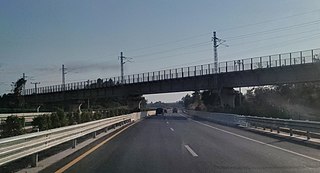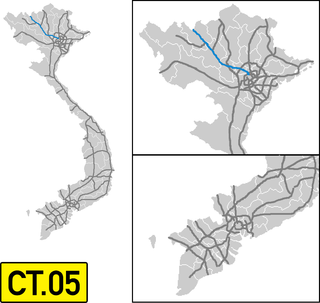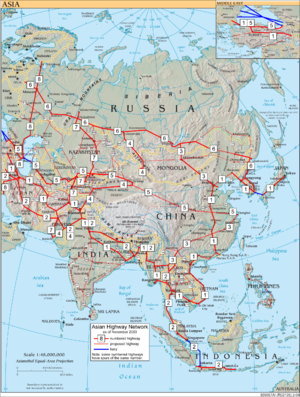
This article concerns the systems of transportation in Laos. Laos is a country in Asia, which possesses a number of modern transportation systems, including several highways and a number of airports. As a landlocked country, Laos possesses no ports or harbours on the sea, and the difficulty of navigation on the Mekong means that this is also not a significant transport route.

Transportation in Vietnam is improving rapidly in terms of both quantity and quality. Road traffic is growing rapidly but the major roads are dangerous and slow to travel on due to outdated design and an inappropriate traffic mix. In recent years, the construction of expressways has accelerated. Air travel is also important for long distance travel. Metro systems are under construction in the two metropolises of Hanoi and Ho Chi Minh City.
Federal Route 3 is a main federal road running along the east coast of Peninsula Malaysia. The 739 kilometres (459 mi) federal highway connects Rantau Panjang in Kelantan until Johor Bahru in Johor. The entire FT3 highway is gazetted as a part of the Asian Highway Network route 18.

Vietnam Railways is the state-owned operator of the railway system in Vietnam. The principal route is the 1,727 km (1,100 mi) single-track North–South Railway line, running between Hanoi and Ho Chi Minh City. This was built at the metre gauge in the 1880s during the French colonial rule. There are also standard gauge lines running from Hanoi to the People’s Republic of China, eventually leading to Beijing, and some mixed gauge in and around Hanoi.

Kunming–Bangkok Expressway is a proposed international expressway running from Kunming, Yunnan province, People's Republic of China, to Bangkok, Thailand via Laos The first expressway sections were opened in 2008.

Asian Highway 2 (AH2) is a road in the Asian Highway Network running 13,107 kilometres (8,144 mi) from Denpasar, Indonesia to Merak, and Singapore to Khosravi, Iran. The route is connected to M10 of the Arab Mashreq International Road Network. The route is as follows:
The Ministry of Development of North Eastern Region is a Government of India ministry, established in September 2001, which functions as the nodal Department of the Central Government to deal with matters related to the socio-economic development of the eight States of Northeast India: Arunachal Pradesh, Assam, Manipur, Meghalaya, Mizoram, Nagaland, Tripura and Sikkim. It acts as a facilitator between the Central Ministries/ Departments and the State Governments of the North Eastern Region in the economic development including removal of infrastructural bottlenecks, provision of basic minimum services, creating an environment for private investment and to remove impediments to lasting peace and security in the North Eastern Region.

The transport infrastructure of Yunnan is served by numerous transport modes, and forms an integral part of the structure Yunnan Province and the Southwest of China. Yunnan is served by several civilian airports and a major highway and rail network. The province is served by a network of bus routes that radiates from the capital city, Kunming.

Asian Highway 3 (AH3) is a route of the Asian Highway Network which runs 7,331 km (4,555 mi) from Ulan-Ude, Russia to Tanggu, China; and Shanghai, China to Chiang Rai, Thailand and Kengtung, Myanmar.

The railway system in Vietnam is owned and operated by the state-owned Vietnam Railways. The principal route, the single track North-South Railway running between Hanoi and Ho Chi Minh City, accounts for 1,726 kilometres (1,072 mi) of the network's total length of 2,600 kilometres (1,600 mi). The national railway network uses mainly metre gauge, although there are several standard gauge and mixed gauge lines in the north of the country.

The Malaysian Expressway System is a network of national controlled-access expressways in Malaysia that forms the primary backbone network of Malaysian national highways. The network begins with the Tanjung Malim–Slim River tolled road which was opened to traffic on 16 March 1966, later North–South Expressway (NSE), and is being substantially developed. Malaysian expressways are built by private companies under the supervision of the government highway authority, Malaysian Highway Authority.

The Kunming–Singapore railway is a network of railways that connects China, Singapore and all the countries of mainland Southeast Asia. The concept originated with the British and French colonial empires, which sought to link the railways they had built in southwest China, Indochina and Malaya, but international conflicts in the 20th century kept regional railways fragmented. The idea was formally revived in October 2006 when 18 Asian and Eurasian countries signed the Trans-Asian railway Network Agreement, which incorporated the Kunming–Singapore railway into the Trans-Asian railway network.

Asian Highway 12 (AH12) is a route of the Asian Highway Network, with a length of 1,195 km that runs from AH3 in Nateuy, Laos, through Muang Xay, Luang Prabang, Vang Vieng, Vientiane, Nong Khai, Udon Thani, Khon Kaen, Nakhon Ratchasima, and Saraburi until its terminus at AH1 in Nong Khae District, Saraburi Province, Thailand.

The Kaladan Road Project is a US$484 million project connecting the eastern Indian seaport of Kolkata with Sittwe seaport in Rakhine State, Myanmar by sea. In Myanmar, it will then link Sittwe seaport to Paletwa in Chin State via the Kaladan river boat route, and then from Paletwa by road to Mizoram state in Northeast India. All components of the project, including Sittwe port and power, river dredging, Paletwa jetty, have been completed, except the under construction Zorinpui-Paletwa road. Originally, the project was scheduled to be completed by 2014, but end-to-end project is expected to be fully operational only by December 2023 as per November 2023 update.

Asian Highway 13 (AH13) is a road in the Asian Highway Network running 1,409 kilometres (876 mi) from Hanoi, Vietnam to Nakhon Sawan, Thailand. The route is as follows:

Asian Highway 14 (AH14) is a road in the Asian Highway Network running 2,004 kilometres (1,245 mi) from Hai Phong, Vietnam to Mandalay, Myanmar connecting AH1 to AH3 in Kunming, Yunnan, China and eventually to AH2. The route is as follows:

India–Myanmar–Thailand Trilateral Highway, 1,360 km (850 mi) long route, is a 4-lane highway under construction under India's Look East policy that will connect Moreh, India with Mae Sot, Thailand via Myanmar. Imphal-Mandalay-Bangkok 1,813 km (1,127 mi) route, consisting of Imphal-Mandalay 584 km (363 mi) and Mandalay-Bangkok 1,397 km (868 mi), is a highway in good condition except for 101 km (63 mi) part of 120 km (75 mi) long Kalewa-Yagyi stretch being built to 2-lane in each direction highway by India.
The ASEAN Smart Cities Network (ASCN) is a collaborative platform that aims to unify smart city development efforts across ASEAN. The ACSN aims to facilitate cooperation on smart city development, broker smart city development projects between city government units and local private sector firms, and secure funding and support for these developments from ASEAN's external partners. The initiative was launched at the 32nd ASEAN Summit as a key deliverable of Singapore's ASEAN Chairmanship in 2018, and its Inaugural Meeting took place on 8 July 2018.
The Vientiane–Vũng Áng railway is a proposed 1,435 mmstandard gauge railway that ran for 555 kilometres (345 mi) between the capital of Laos, Vientiane, and port in Hà Tĩnh Province via Mụ Giạ Pass on the border between Laos and Vietnam.

The Hanoi–Lao Cai Expressway is an expressway in Vietnam, connecting Noi Bai near Hanoi with the northwest border town of Lào Cai, towards Kunming in China. The expressway has major importance in facilitating trade between Vietnam and China and in developing northwest Vietnam. It connects to G8011 Kaiyuan–Hekou Expressway on the Chinese side of the border.




















